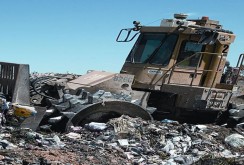
Pigs are a big deal. Four in 10 pounds of meat eaten worldwide is pork and, in the United States alone, there are as many as 75 million or more pigs being grown for food. Since each pig can produce half to three-quarters of a ton of manure on its way to market, their wastes are a big deal, too.
Collected in open-air pits as they used to be on the 10 Murphy Brown hog farms in southwest Utah, the waste can be a smelly threat to both water and air quality. Connected to that odor is methane, a greenhouse gas more than 20 times as potent as CO2.
Starting at the end of 2013, the waste from a million pigs a year, raised by the Smithfield Foods subsidiary, has been used to provide enough electricity for about 3,000 homes in a project called Blue Mountain Biogas.
The malodorous by-product produced annually by Smithfield’s temporary porcine residents is fed into an anaerobic digester, a closed container or a covered basin with all the oxygen excluded. As the bacteria eat the manure, the methane gas is collected and burned to generate electricity.
Alpental Energy Partners of Provo, Utah, developed and operates the $17 million, 3.2 megawatt electric plant. They project it will generate 25 million kilowatt-hours a year, operating 24 hours a day.
The Blue Mountain Biogas project is one of the world's largest producers of electrical energy from swine waste, located on the largest pig farm in the western U.S. Smithfield is the world’s largest pork producer. The electricity is sold to a Utah municipality, while the carbon credits and renewable energy certificates are sold on the cap-and-trade carbon market.
The American Biogas Council counts just under 200 farms in the U.S. that are equipped with anaerobic biogas digesters. Wastewater treatment and landfill gas projects add about 2,000 more facilities here, compared with around 10,000 such plants in Europe.










